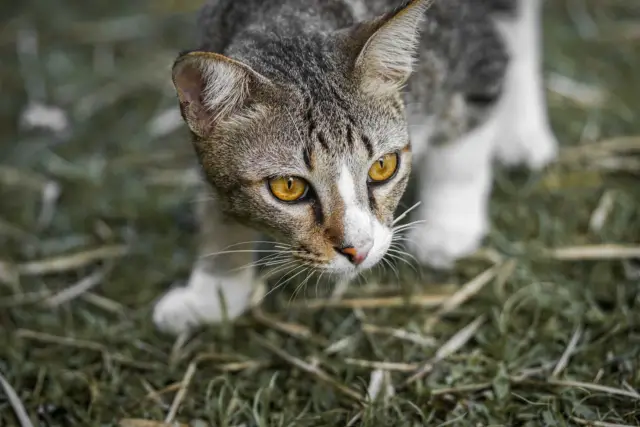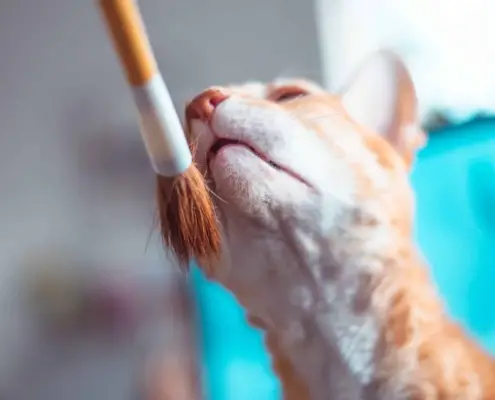
Cats are fascinating creatures with unique behaviors that often leave their human companions puzzled. One such behavior that many cat owners have experienced is their feline friend’s tendency to target ankles. This peculiar behavior can range from a playful pounce to a seemingly aggressive attack. In this article, we will delve into the reasons behind why cats target ankles, exploring both their predatory nature and protective instincts.
Understanding the Predatory Nature of Cats
To comprehend why cats target ankles, it is crucial to understand their innate predatory nature. Cats are natural-born hunters, and despite their domestication, they still possess the instincts and behaviors of their wild ancestors. These instincts include stalking, pouncing, and capturing prey. When cats target ankles, they are essentially displaying their hunting skills, albeit in a modified form.
Factors That Contribute to Ankle Targeting Behavior
Several factors can contribute to a cat’s tendency to target ankles. One such factor is the size and movement of the ankles resembling small prey, triggering the cat’s hunting instincts. The quick and unpredictable movements of ankles can mimic the behavior of small rodents or birds, making them irresistible targets for a cat’s predatory nature. Additionally, some cats may have a higher prey drive due to genetics or past experiences, increasing their inclination to target ankles.
Another contributing factor to ankle targeting behavior is the lack of appropriate outlets for a cat’s energy and natural instincts. Cats require mental and physical stimulation to stay happy and fulfilled. Without adequate playtime and environmental enrichment, they may resort to ankle targeting as a way to release pent-up energy and engage in their natural hunting behaviors.
The Role of Play in Ankle Targeting
Play is an integral part of a cat’s life, serving as a means to release energy and stimulate their minds. Engaging in play with your cat using interactive toys can help redirect their focus away from ankle targeting. By providing them with appropriate play sessions, you can satisfy their need for hunting-like behaviors in a controlled and safe manner. Regular play sessions also strengthen your bond with your feline companion and provide an opportunity for exercise, reducing the likelihood of ankle targeting.
Protective Instincts and Ankle Targeting
While playfulness is often a significant factor in ankle targeting behavior, protective instincts can also come into play. Cats are territorial animals, and they perceive any perceived threat to their territory or human family as a potential danger. When a cat targets ankles, it may be attempting to protect its territory or loved ones. This behavior can be triggered by unfamiliar visitors, other pets, or even sudden loud noises. Understanding and addressing the underlying cause of their protective instincts can help mitigate ankle targeting behavior.
Potential Reasons Behind Ankle Targeting
In addition to playfulness and protective instincts, several other reasons may contribute to a cat’s ankle targeting behavior. One possible reason is boredom. Cats are intelligent creatures that require mental stimulation. Without appropriate outlets for their curiosity and problem-solving skills, they may resort to ankle targeting as a form of entertainment. Another reason could be redirected aggression. If a cat becomes frustrated or agitated by an unattainable target, such as a bird outside the window, they may redirect their aggression towards the nearest moving object, which could be an ankle.
How to Prevent Ankle Targeting Behavior
Preventing ankle targeting behavior starts with providing your cat with a stimulating and enriching environment. Ensure they have access to interactive toys, scratching posts, and climbing structures to satisfy their natural instincts. Regular play sessions and mental stimulation activities, such as puzzle toys or treat-dispensing toys, can also help redirect their focus away from ankles.
Consistency is key when addressing ankle targeting behavior. Reinforce positive behaviors and discourage ankle targeting by using deterrents such as noise distractions or gentle redirection. It is crucial to avoid any form of punishment, as it can lead to fear or anxiety in your cat. Instead, focus on positive reinforcement and reward-based training methods.
Redirecting the Behavior Through Play and Enrichment
Redirecting your cat’s ankle targeting behavior towards more appropriate outlets is essential. Engage in interactive play sessions with your cat using toys that mimic the movements of prey. This can help satisfy their hunting instincts while diverting their attention away from ankles. Additionally, provide environmental enrichment by setting up vertical spaces, hiding treats around the house, or introducing new and engaging toys. By offering alternative outlets for their natural behaviors, you can gradually shift their focus away from ankle targeting.
Seeking Professional Help for Persistent Ankle Targeting
If your cat’s ankle targeting behavior persists despite your best efforts, it may be beneficial to seek professional help. A veterinarian or animal behaviorist can provide expert guidance and develop a tailored behavior modification plan. They can assess your cat’s overall health, evaluate their environment, and provide strategies to address the underlying causes of ankle targeting. With their expertise, you can work towards resolving the behavior and ensuring the well-being of both you and your feline companion.
Conclusion
Understanding why cats target ankles involves delving into their predatory nature and protective instincts. Ankle targeting behavior can be attributed to a combination of playfulness, protective instincts, boredom, and redirected aggression. By providing appropriate outlets for their energy, engaging in regular play sessions, and seeking professional help if needed, you can redirect your cat’s focus away from ankles and foster a harmonious relationship with your feline companion. Remember, patience, consistency, and positive reinforcement are key when addressing any unwanted behaviors in cats.
If you enjoyed my article, I would appreciate you sharing it with your network.

Sima Ndlebe
Sima writes for CatBuzz. He is interested in Cats, Health and Fitness, and Entrepreneurship.
Published: 24 April 2024



